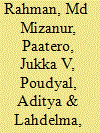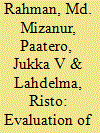|
|
|
Sort Order |
|
|
|
Items / Page
|
|
|
|
|
|
|
| Srl | Item |
| 1 |
ID:
125586


|
|
|
|
|
| Publication |
2013.
|
| Summary/Abstract |
Rural electrification is essential for bringing about social and economic developments, but the progress is distressingly slow in most developing countries. The Bangladesh Rural Electrification Program (BREP) has been highlighted as a positive case among developing countries, but from 2006 onwards there have been doubts about the program's chances of success. In this paper, we examine the rural electrification practices in Bangladesh and evaluate the claim that, whereas they were successful up to 2005, they then began to decline in terms of their performance. This study determines the factors behind the initial success of the program as well as those that account for the recent downturn in BREP. We found that the BREP was a clear success in terms of its growth and progress; however, its performance has been declining since 2006. The key driving factors for the success of this program had to do with prioritizing system investment, community involvement, anti-corruption features, standardized practices and performance-based incentives while excluding political parties. The major issues accounting for the decline were the lack of organizational autonomy, a shortage of funding, unrealistic tariffs, and power supply shortages. Renewable-based, off-grid technologies have been successfully supplementing the on-grid program in remote areas.
|
|
|
|
|
|
|
|
|
|
|
|
|
|
|
|
| 2 |
ID:
125446


|
|
|
|
|
| Publication |
2013.
|
| Summary/Abstract |
Rural electrification (RE) can be modelled as a multifactorial task connected to a large number of variables: decision makers need to choose the appropriate options by considering not only the techno-economic competitiveness but also socio-cultural dynamics and environmental consequences, making the task intricate. Many rural electrification projects have failed due to lack of attention to the issues beyond financial and technical dimensions. This paper presents a standardized approach for decision making concerning the extension of electricity services to rural areas. This approach first determines whether the supply provision should be grid expansion or off-grid on the basis of levelized cost of delivered electricity. If the grid expansion is found nonviable over off-grid options then a multicriteria decision aiding tool, SMAA-2 (Stochastic Multicriteria Acceptability Analysis), will evaluate off-grid technologies by aggregating 24 criteria values. While applying this approach, the delivered costs of electricity by the grid in remote areas within the 1-25 km distances vary in a range of 0.10-7.85 US$/kW h depending on the line lengths and load conditions. In the off-grid evaluation, the solar PV (photovoltaic) and biogas plants are found as the most preferable alternatives with 59% and 41% acceptability in their first rank, respectively.
|
|
|
|
|
|
|
|
|
|
|
|
|
|
|
|
| 3 |
ID:
110735


|
|
|
|
|
| Publication |
2011.
|
| Summary/Abstract |
Combined heat and power (CHP) plants dominate the heating market in China. With the ongoing energy structure reformation and increasing environmental concerns, we propose gas-fired boilers to be deployed in underperforming heating substations of heating networks for peak load compensation, in order to improve both energy efficiency and environmental sustainability. However, due to the relatively high price of gas, techno-economic analysis is required for evaluating different combined heating scenarios, characterized by basic heat load ratio (ß). Therefore, we employ the dynamic economics and annual cost method to develop a techno-economic model for computing the net heating cost of the system, considering the current state of the art of cogeneration systems in China. The net heating cost is defined as the investment costs and operations costs of the system subtracted by revenues from power generation. We demonstrate the model in a real-life combined heating system of Daqing, China. The results show that the minimum net heating cost can be realized at ß=0.75 with a cost reduction of 16.8% compared to coal heating alone. Since fuel cost is the dominating factor, sensitivity analyses on coal and gas prices are discussed subsequently.
|
|
|
|
|
|
|
|
|
|
|
|
|
|
|
|
|
|
|
|
|